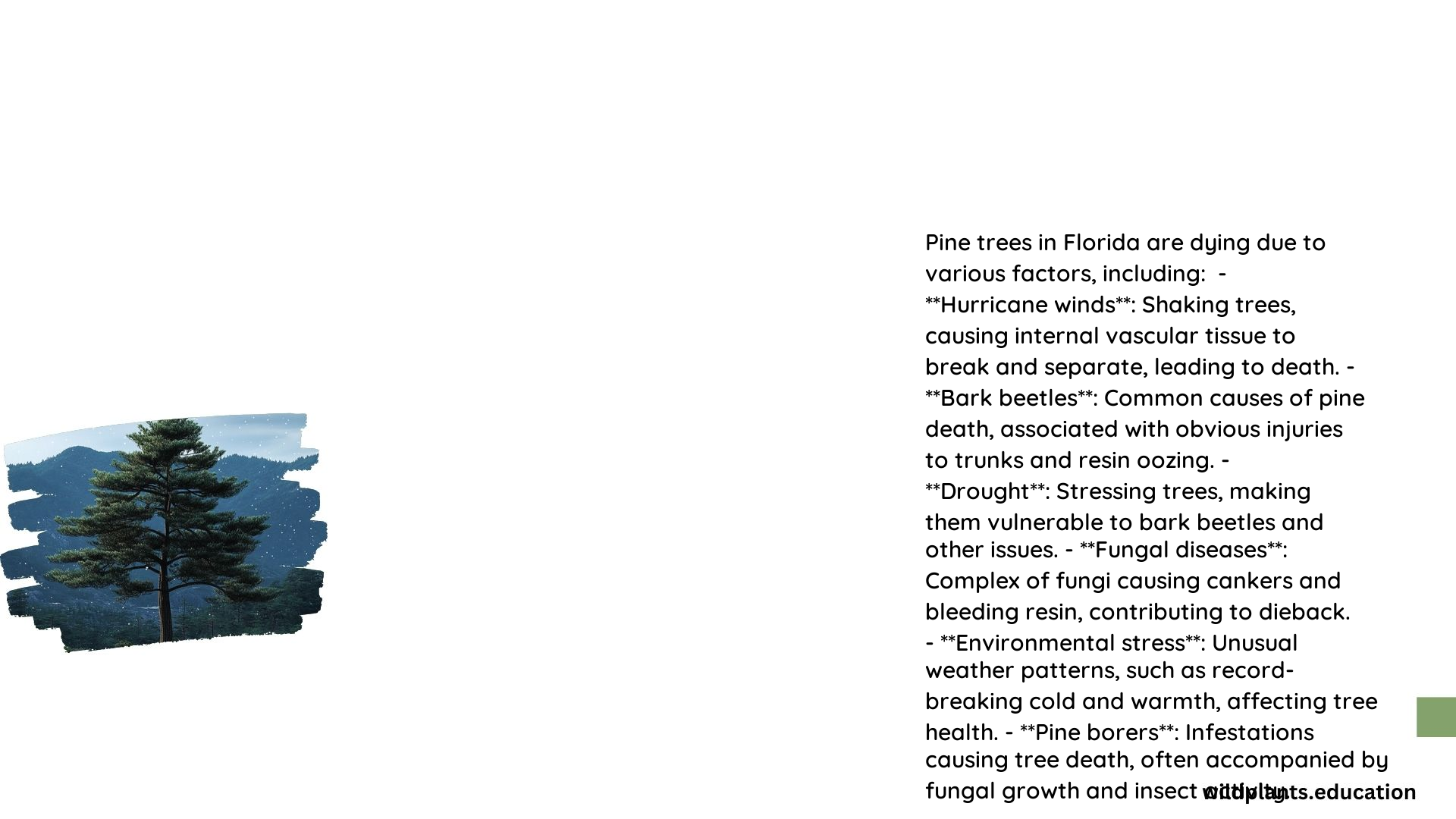The decline of pine trees in Florida is a complex issue involving various environmental factors, diseases, and pests. This comprehensive analysis will explore the primary reasons for pine tree mortality in Florida, common causes of pine tree death, identification techniques for bark beetle infestations, and effective prevention and treatment strategies.
What are the Primary Reasons for Pine Tree Mortality in Florida?

- Bark Beetles:
- The southern pine beetle (SPB) is one of the most destructive pests of pines in Florida, capable of infesting all species of pine trees and causing widespread tree mortality.
- In 2001, SPB outbreaks damaged 17,599 acres of Florida pine forest, causing an estimated $38 million in damages.
-
SPB infestations can be identified by pitch tubes spread along the main stem of the tree, with attacks characterized by a zig-zag to “s” shape.
-
Root Rot and Other Pathogens:
- Root rot caused by fungi like Heterobasidion irregulare can significantly impact loblolly pine health, with unhealthy sites having a higher incidence of this root fungal pathogen.
-
Other pathogens like fusiform rust and pitch canker can also contribute to pine tree mortality.
-
Environmental Factors:
- Climatic changes, such as drought and flooding, can weaken pine trees and make them more susceptible to pests and diseases.
- Soil disturbances, excessive water or fertilizer, and high pH can also contribute to pine tree decline.
What are the Common Causes of Pine Tree Death in Florida?

- Bark Beetles:
-
Bark beetles, particularly the southern pine beetle, are significant contributors to pine tree mortality in Florida. They infest stressed and dying pine trees, causing further damage and death.
-
Root Rot:
-
Root rot caused by fungi like Heterobasidion irregulare can lead to tree mortality by compromising the tree’s root system.
-
Fusiform Rust:
- Fusiform rust, a native disease caused by the fungus Cronartium quercuum f. sp. fusiforme, can deform and kill pines by forming spindle-shaped galls on branches or stems.
How Can You Identify Bark Beetle Infestations?
- Visual Symptoms:
- Look for pitch tubes spread along the main stem of the tree, which are indicative of SPB infestations.
-
Check for eggs that are 1.5 x 1.0 mm oval and pearly white, as well as the distinctive zig-zag to “s” shape of SPB attacks.
-
Timing of Attacks:
-
SPB attacks often occur in the spring and summer months, with the adult beetles emerging from infested trees to attack new hosts.
-
Specific Measurements of Damage:
- Measure the size of exit holes and pitch tubes to determine the extent of the infestation.
What are the Prevention and Treatment Strategies for Pine Tree Decline?
- Prevention:
- Avoid planting invasive ornamental plants and properly remove any existing ones to prevent the spread of invasive species.
- Clean clothing, vehicles, and equipment after hiking or fishing to prevent the spread of invasive species from other areas.
-
Choose livestock hay and feed carefully to avoid introducing invasive species.
-
Treatment:
- Remove and replace declining trees to prevent the spread of pests and diseases.
- Rapidly salvage trees seriously damaged by disease, fire, and storms to prevent further damage.
- Use approved insecticides and fungicides according to label instructions to control pests and diseases.
What are the Best Practices for Maintaining Pine Tree Health?
- Promote Tree Health:
-
Keep trees healthy by minimizing tree stress, avoiding soil disturbances, and maintaining proper soil conditions.
-
Monitor for Pests and Diseases:
-
Regularly inspect trees for signs of pests and diseases, such as bark beetles, root rot, and fusiform rust.
-
Consult Professionals:
- Consult certified arborists or foresters if you suspect pest or disease infestations, as they can provide professional evaluations and recommendations for treatment.
Reference:
- Miller’s Tree Service – Make an Attack Plan for Pine Tree Damage
-
https://www.millertreesrv.com/make-an-attack-plan-for-pine-tree-damage/
-
Florida Museum – Tell Me About: Southern Pine Beetle in Florida
-
https://www.floridamuseum.ufl.edu/earth-systems/blog/tell-me-about-southern-pine-beetle-in-florida/
-
University of Florida – Key Plant, Key Pests: Pine Species (Pinus sp.)
- https://edis.ifas.ufl.edu/publication/EP565.
